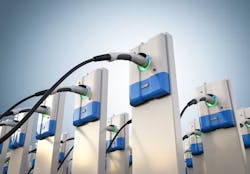There is some cause for concern that the movement to “electrify everything” will overtax an already aging grid infrastructure when charging so many new vehicles. Another challenge that EVs face is the perception that power from the grid is still “dirty,” i.e. generated from less sustainable resources, such as fossil fuels. With the number of EVs on the road increasing every day, we face a new industry need to simplify the journey to adoption by addressing these concerns. This is where a microgrid can smooth out those bumps in the road, providing an organic solution for power capacity to keep up with demand and removing the need for long, costly grid upgrades.
Microgrids can support EV fleets as an energy source, whether primary or backup power, by relying on a mix of localized solar power and on-site energy storage. This is especially important for fleets with large load capacity requirements and time sensitive regulatory mandates. Microgrids can remove capital burden and performance risks that may have been a concern as they increase their decarbonization efforts.
With the Inflation Reduction Act, infrastructure bills, charging and fueling grants and location-specific mandates, EV and microgrid projects are now more necessary and more affordable. We will soon see drayage fleets face logistical restrictions and even bans on gas-powered vehicles in some areas, but the broad support and incentives from both state and federal levels will speed up electrification efforts. Microgrids provide an additional solution for companies to achieve those mandates in a less capital intensive and more sustainable way, lowering the overall cost for the paradigm shift toward electric mobility.
Leveraging the Inflation Reduction Act.
The resiliency aspect of a microgrid solution for EV infrastructure is becoming an increasingly important benefit. As we see EV fleets grow from their pilot stage to widespread adoption, resiliency must be part of the conversation to ensure operational success. Independent studies have estimated that fleet electrification can reduce greenhouse gas emissions by 62%; however, the use of diesel generators during a grid outage would drive those emissions back up. Incorporating a microgrid can meet the power and resiliency demands for the fleet, providing renewable electrification at scale. Looking at uptime and resiliency measures is especially critical when you consider natural events and grid stability by region, where any measure to support resiliency of operations is vital.
By building in a microgrid, EV users can reduce peak demand on the grid and shift their highest hours of energy consumption to times when energy costs are lower, saving not only planetary resources, but financial ones as well. However, fleet managers may face challenges in predicting new operations, maintenance, and financial structures, seeing only the initial capital-intensive investment. It is important to focus on the long-term ease of realizing financial and operational benefits in a scenario where the load is guaranteed. Although the upfront costs of EVs are higher and standard vehicle operations have been understood for decades, it's crucial to consider the total cost of ownership and the various ways an EV fleet operates. There is predictability in daily usage and duty cycles that can forecast the load for a microgrid. Fleets and microgrids will intersect to support a more predictable load, resulting in streamlined costs and an overall reduction in OPEX.
For successful deployments of EV infrastructure, it is crucial for developers to leverage cross-industry energy expertise. Vendor- and technology-agnostic partners with a broad skillset and in-depth energy experience will survey the market to build a comprehensive analysis of facility operations and capacity needs. Customized solutions that incorporate on-site renewables and energy management are vital to support the unique needs of every customer and deliver solutions at the lowest cost. This approach works toward a decarbonized future well past the purchase of a vehicle.
As all routes lead to the intersection of electric vehicles and microgrid power, working with an experienced long-term energy partner can smooth the way with a comprehensive solution that provides renewable power, grid integration, resiliency, and reduced operating expenses.









